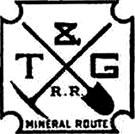Tonopah
Tonopah's story began May 19, 1900. Jim Butler was en route from Belmont to the camp of Klondike with two mules when he stopped to camp at a location called Tonopah - derived from the Shoshone words for "greasewood" and "water". Early in the morning, one of the mules strayed from the camp. Butler went to find it, and noticed an outcropping that appeared rich in silver. He gathered some samples and his mule, and continued on his way. In Klondike, an assayer determined that Butler's samples were nothing more than iron.
Butler was determined that he had struck it rich with his find, and collected more samples. Later in the year Butler's friend Tasker L. Oddie paid to have these new samples assayed by Walter Gayhart in Austin. The results showed a value of up to $600 per ton, and an Indian messenger was immediately dispatched to find Butler and give him the good news. Butler, however, failed to return to his strike right away. News quickly spread and soon miners from Klondike were searching for the discovery, to no avail. Butler finally returned with his wife Belle on August 25th and located the first claims: the Desert Queen, Burro, and Mizpah. Butler worked these with Oddie and another partner, Wilse Brougher. The first shipment to Austin raked in $600.

In December, Butler began issuing leases for a 25% return on all ore produced. By June 1901, the camp known as Butler City had a population of around 650 and a newspaper: the Tonopah Bonanza. By the end of 1902, the town had reached over 3000, with some 32 saloons, two dancehalls, two newspapers, two churches, and a school. During that winter, additional ore bodies were also discovered. In April 1903, Tonopah stocks were listed on the San Francisco Exchange. That year a narrow gauge railroad was also constructed to connect with the Carson & Colorado near Rhodes. Tonopah continued to boom and grow, and in May 1905 it took the county seat from Belmont. That same year, the Tonopah Railroad was standard gauged and renamed the Tonopah & Goldfield Railroad after a connection was made to that town.
By 1907, Tonopah had become a respectable town with all the modern amenities - banks, luxury hotels, cafes, schools, an opera house, electricity and water service, and a downtown of sturdy stone buildings as tall as four and five stories. Development peaked between 1910 and 1914, when the average annual yield from Tonopah's mines was $8.5 million. New mills were built in Tonopah, and an earlier mill at Millers (about 12½ miles away by rail) was joined by a second. Tonopah had become the most prosperous town in the West.
Tonopah continued to produce around $900,000 per year until the Depression, but four major companies - the Tonopah Mining, Tonopah-Belmont Development, Tonopah Extension, and West End Consolidated - all remained active until World War II. During this time, Tonopah also became home to the Tonopah Army Air Field, which was active from 1942 until 1945 and brought many to Tonopah.
In October 1947, the Tonopah & Goldfield Railroad ceased operations and mining in Tonopah was finished the next year. Howard Hughes' Summa Corporation purchased claims in 1968, but they never reopened. Total production for the Tonopah District is estimated at more than $150 million. Today the town holds onto a population of nearly 2500, and is a popular stop between Reno and Las Vegas. Tonopah's largest employer is the military's Tonopah Test Range, located to the southeast, and in 2015 the massive Crescent Dunes Solar Energy Project was completed at a cost of $980 million.











































